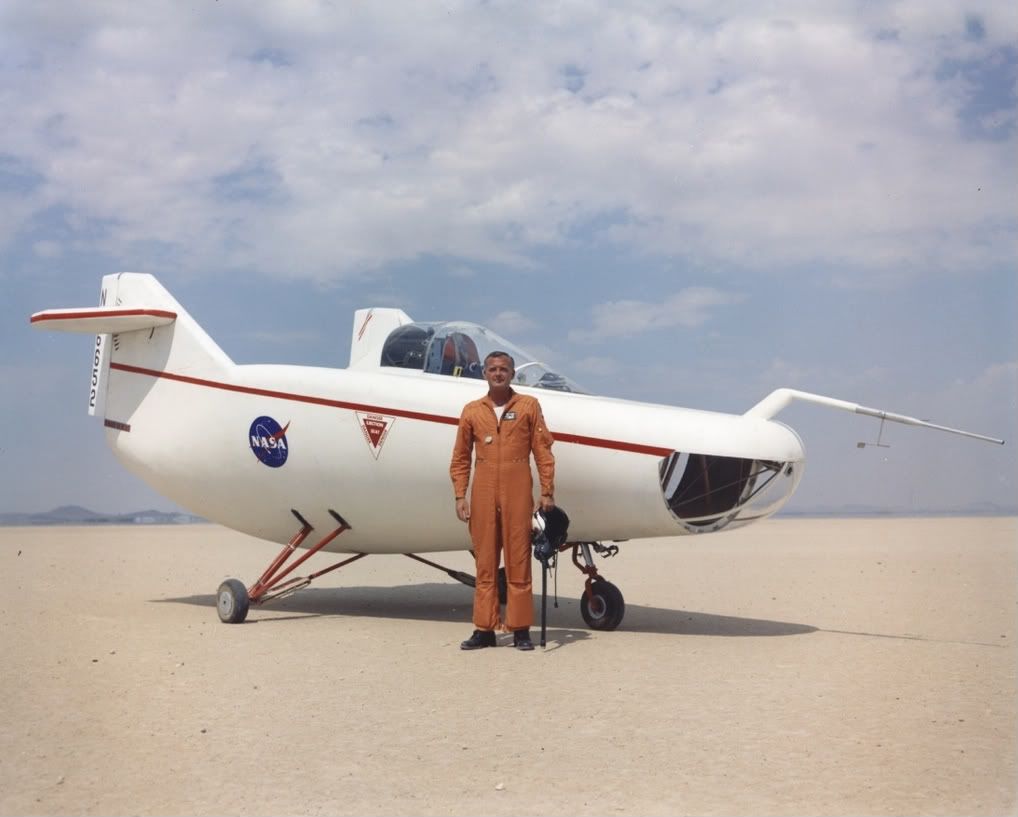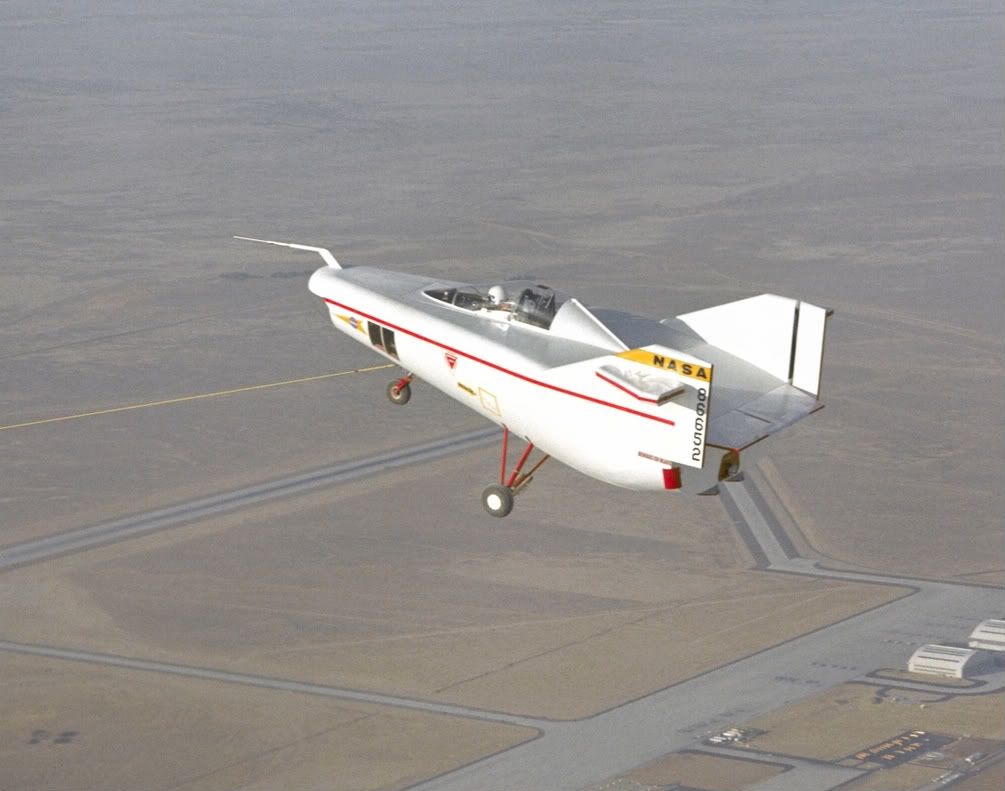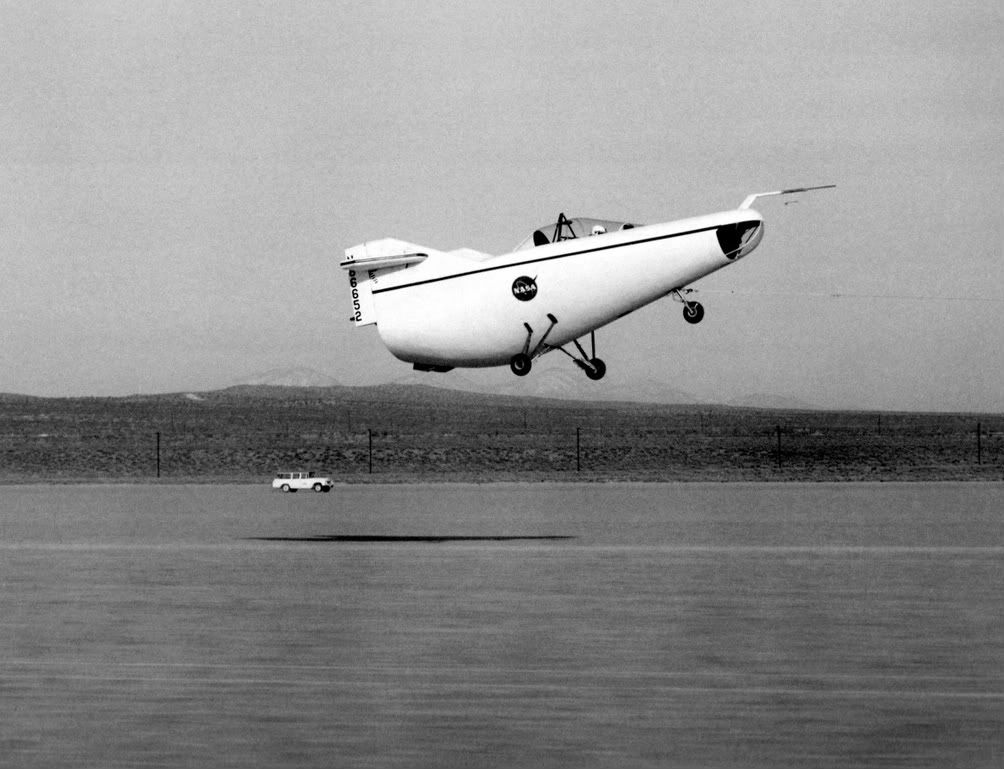Flown from 1963 until 1966 the M2-F1(M referring to manned and F referring to flight version), dubbed the "flying bathtub" by the media, was the first design concept for a safe return vehicle that could be steered during atmospheric re entry. The wingless aircraft design was conceived as a means of landing an aircraft horizontally after atmospheric reentry. The absence of wings making the extreme heat of re-entry less damaging to the vehicle.
 August 1963, Milt Thompson, test pilot and early champion of the project, on Rogers dry lakebed with m2-f1, Image Credit: NASA Dryden Flight Research Centre photographic collection.
August 1963, Milt Thompson, test pilot and early champion of the project, on Rogers dry lakebed with m2-f1, Image Credit: NASA Dryden Flight Research Centre photographic collection.Based on 1950's design concept of Alfred J. Eggers at the Ames Research Center, California. The M2-F1 was a precursor to the M2-F2, M2-F3, HL-10, X-24A, and X-24B lifting bodies. Their unpowered approaches and landings showed that re entry vehicles, like the Space Shuttles, did not need to carry the fuel and engines required for conventional powered landings. This enabled increased payload capacity and hence more cost effective launches.
In February 1962 R. Dale Reed, an engineer at Dryden, built a model based upon the Ames M2 design and air-launched it from a radio controlled "mothership." Film taken from the models flight persuaded Dryden facilities director, Paul Bickle, to green light the construction of a full-scale version, to be used as a wind tunnel model and possibly flown as a glider.
 1963 photo shows Pontiac tow vehicle in a hanger with the m2-f1 lifting body.Image Credit : NASA Dryden Flight Research Centre photographic collection
1963 photo shows Pontiac tow vehicle in a hanger with the m2-f1 lifting body.Image Credit : NASA Dryden Flight Research Centre photographic collection The M2-F1 was built over a four-month period in 1962-63. The design stuck to the NASA concept of better, faster, cheaper, being built for about $30,000, with an additional $10,000 for the all important ejection seat. The design costs were kept low with NASA engineers building the tubular steel interior frame in house, reusing the landing gear from a Cessna 150, and outsourcing the plywood shell construction to Gus Briegleb and co, a local sailplane builder.
For the initial use of a ground-tow vehicle NASA engineers used a souped up Pontiac convertible. On April 5 1963, Using a 1000 foot rope fastened to the NASA Pontiac, at Rogers Dry Lake, Milt Thompson piloted the M2-F1 for the first time on-tow. The speed was 86 miles per hour, allowing the craft to just about become airborne. Speeds on-tow later reached 110 miles per hour, enabling the M2-F1 to rise about 20 feet in the air before gliding for about 20 seconds.
 M2- F1 mounted in Ames Research Centre wind tunnel Image Credit : NASA Dryden Flight Research Centre photographic collection.
M2- F1 mounted in Ames Research Centre wind tunnel Image Credit : NASA Dryden Flight Research Centre photographic collection.In the spring of 1963 the M2-F1 was shipped to the Ames Research Center wind tunnel For two weeks of tests. After this testing phase it was decided to use a C-47 tow plane to undertake aero tows, the first of which was on August 16 1963. Rockets were also installed in the tail to extend the landing flare for about 5 seconds.
 1964 picture of M2-F1 towed behind C-47 Image Credit : NASA Dryden Flight Research Centre photographic collection
1964 picture of M2-F1 towed behind C-47 Image Credit : NASA Dryden Flight Research Centre photographic collection The initial tow from the C-47 was released at 12,000 feet. The lifting body descended at approximately 3600 feet per minute. When the descent had reached 1000 feet, the nose of the M2-F1 was lowered to increase speed to nearly 150 miles per hour, the flare was at 200 feet from a 20-degree dive. The landing was reported as smooth.
Overall, more than 400 ground tows and 77 aircraft tow flights were carried out with the M2-F1. The success of Dryden's M2-F1 program led to NASA's development and construct the M2-F2 and the HL-10 programmes, and the U.S. Air Force's X-24 program.
 1965 photograph of the M2-F1 in flight Image Credit : NASA Dryden Flight Research Centre photographic collection
1965 photograph of the M2-F1 in flight Image Credit : NASA Dryden Flight Research Centre photographic collectionThe M2-F1 programme had demonstrated the feasibility of the lifting-body concept for horizontal landings of atmospheric entry vehicles, and that projects could be done cheaply and quickly. The entire project had cost approximately $50,000, excluding salaries of government employees assigned to the project.
More Information.







1 comment:
This is really sweet! Just wonderful post written by you. Thank you for your kind post...Impressive work…Bangalore Escorts
Post a Comment